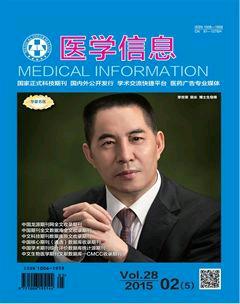己酮可可碱治疗尿毒症患者难治性贫血的研究
刘芸辉
摘要:目的 检验己酮可可碱可能改进肾衰竭患者对重组人促红素的反应。方法 13例肾功能衰竭患者合并对重组人促红素抵抗性贫血入选。入选标准为治疗前每周注射促红素剂量≥12000IU/w满6个月而血红蛋白<10.7g/dl。患者服用己酮可可碱400mg,1次/d,连续使用12w。结果 13例患者治疗前平均血红蛋白浓度为(8.6±1.2)g/dl,12w后己酮可可碱治疗后,平均血红蛋白浓度上升至(10.7±1.3)g/dl(P=0.000)。结论 己酮可可碱能显著地提高肾功能衰竭合并对重组人促红素抵抗性贫血患者的血红蛋白浓度。
关键词:尿毒症;肾性贫血;己酮可可碱
肾性贫血是尿毒症患者最常见的并发症之一。贫血的原因较多,如缺铁[1]、左旋肉碱缺乏[2]、继续发甲状旁腺功能亢进[3,4]、感染和透析不充分[5]等,但促红细胞生成素(erythropoietin, EPO)相对和绝对缺乏是肾性贫血的最主要原因[6]。人组红细胞生成素(recombinant human erythropoietin, rh-Epo)应用临床已经20余年,对肾性贫血具有划时代的意义。90~95%的尿毒症贫血患者使用rh-Epo后能有效地纠正贫血。尽管如此,仍有小部分但重要的患者,在排除缺铁、甲状旁腺亢进等因素外,对rh-Epo反应不够,使得其在连续使用大剂量rh-Epo(>12000iu/Week)皮下注射或静脉注射6个月后仍处于贫血状态(血红蛋白低于110g/L,又称难治性贫血)[7]。
己酮可可碱用于治疗尿毒症患者rh-Epo抵抗性贫血的报道较少[20]。在这里,我们再次评估了己酮可可碱用于治疗尿毒症患者rh-Epo抵抗性贫血的有效作用。
1资料与方法
1.1入选标准 为在我院连续2013年1月~4月在血液透析6月以上,使用rh-Epo≥12000IU/周满6个月但血色素(Hb)仍小于10.7g/dl的尿毒症患者。除外继发性甲状腺旁腺功能亢进、缺铁性贫血、铝中毒、急性感染、血清球蛋白大于40g/L、服用血管紧张素转换酶抑制剂(ACEIs)、茶碱制剂及雄激素的患者。共用13例患者入选,其中7例男性,6例女性。入选对象在年龄(平均年龄54.00±11.67岁)、性别(男女比1.18),初始血红蛋白浓度(8.6±1.2g/dl)、透析时间(54.92±25.20月)方面没有明显的差异。
所有患者临床状态稳定。患者服用己酮可可碱400mg,1次/d,连续使用12w。实验开始前及结束后分别抽血测定血红蛋白浓度。
1.2统计分析 使用SPSS软件(11.5版本)做统计分析。结果用x±s方式表达。治疗前后变量用配对t检验对比。
2结果
己酮可可碱对血红蛋白浓度的影响。在实验开始前、治疗后12w末分别测定血红蛋白浓度,治疗前(8.6±1.2)g/d,治疗后(10.7±1.3)g/dl,两组差异有统计学意义,P<0.05。
3讨论
己酮可可碱是甲基黄嘌呤衍生物, 一种磷酸二酯酶抑制剂,主要用于四肢血管疾病的治疗,关于治疗肾性贫血的报道很少。在尿毒症患者中,对人组红细胞生成素反应缺乏可能是归因于患者免疫功能增加[8]。已知某些炎症因子如γ干扰素(interferon-gamma,IFN-γ)、肿瘤坏死因子(tumor necrosis factor-alfa ,TNF-α)及白细胞介素(interleukin-1,IL-1)在体外可以抑制红细胞生成[9,10]。这些炎症因子物质可以通过缩短红细胞寿命、钝化EPO反应及阻碍红细胞集落对EPO的反应[11-13],使得红细胞生成障碍,继而产生贫血。据研究报道己酮可可碱在炎症状态下减少嗜中性粒细胞生成氧自由基[15,16]及影响巨噬细胞功能[17],具有调节免疫的作用。己酮可可碱可以降低肿瘤坏死因子的产量[19]。
己酮可可碱的抗炎特性通过抑制磷酸二酯酶活性、抑制T细胞IFN-γ及单核细胞TNF-α的产量来调节的[17]。一项关于纯T细胞的研究报道显示己酮可可碱减少刺激性TNF-α、IL-5和IL-10的产量[21]。在过敏性肺炎的小鼠模型中,己酮可可碱可以减少刺激性脾细胞源行的IFN-γ22。TNF-α被认为在炎症性贫血的发病中起重要作用[5,23]。因此我们可以推测,己酮可可碱对EPO抵抗性贫血的有效作用与其抗炎性特性有关。
本研究显示了连续使用己酮可可碱3个月可以明显地增加rhu-Epo抵抗性贫血尿毒症患者的血红蛋白浓度。早前,Navarro等人发现己酮可可碱的抗炎症因子特性可以提高晚期肾衰竭贫血患者的血液状态,因为在己酮可可碱治疗患者中血清TNF-α浓度降低并血红蛋白浓度增加[19]。因此,我们认为rhu-Epo低反应性可能归因于这些增加的炎症因子的产物。这发现支持在治疗炎症性贫血时拮抗这些促炎细胞因子的作用是有效的观点。
参考文献:
[1]刘可欣,朱兰,唐尧,等. 肾性贫血治疗中静脉铁剂的使用现状及其合理用药 [J]. 预防医学情报杂志,2008,5,24(5):390-392
[2]陈慧勤.左旋卡尼汀与促红细胞生成素治疗肾性贫血[J].中国血液流变学杂志,2005,15(I):123-124.
[3]朱维平,高飞,王益忠,等.继发性甲状旁腺功能亢进与贫血[J].中国血液净化,2005,4(4):232-234.
[4]Coen G,Calabria S,Bellinghieri G,et al.Parathyroidectomy in chronic renal failure:short-and long-term results on parathyroid function,blood pressure and anemia[J].Nephron,2001,88(2):149-155.
[5]Sitter T,Bergner A,Schiffl H.Nephrol Dial Transplant,2000,15(1)207-211.
[6]NKF-K/DOQ慢性肾脏病贫血治疗的临床实践指南[J].中国血液净化,2007,6(8):452-458.
[7]Stenvinkel P. The role of inflammation in the anaemia of end-stage renal disease[J].Nephrol Dial Transplant,2001,16(Suppl 7):36-40.
[8]Macdougall IC, Cooper A. The inflammatory response and epoetin sensitivity[J].Nephrol Dial Transplant,2002,17(Suppl 1):48-52.
[9]Means RT Jr, Dessypris EN, Krantz SB. Inhibition of human erythroid colony-forming units by interleukin-1 is mediated by gamma interferon[J].J Cell Physiol,1992,150:59-64.
[10]Allen DA, Breen C, Yaqoob MM, Macdougall IC. Inhibition of CFU-E colony formation in uremic patients with inflammatory disease: Role of IFN-gamma and TNF-alpha[J].J Investig Med,1999,47:204-211.
[11]Means RT Jr. Pathogenesis of the anemia of chronic disease: A cytokine-mediated anemia[J]. Stem Cells,1995,13:32-37.
[12]Rogiers P, Zhang H, Leeman M, et al. Erythropoietin response is blunted in critically ill patients[J].Intensive Care Med,1997,23:159-162.
[13]Ward A, Clissold SP. Pentoxifylline. A review of its pharmacodynamic and pharmacokinetic properties,and its therapeutic efficacy[J].Drugs,1987,34:50-97.
[14]Thiel M, Bardenheuer H, Poch G, et al. Pentoxifylline does not act via adenosine receptors in the inhibition of the superoxide anion production of human polymorphonuclear leukocytes[J]. Biochem Biophys Res Commun,1991,180:53-58.
[15]McDonald RJ. Pentoxifylline reduces injury to isolated lungs perfused with human neutro-phils[J].Am Rev Respir Dis,1991,144:1347-1350.
[16]Williams JH Jr, Heshmati S, Tamadon S, et al. Inhibition of alveolar macrophages by pentoxifylline[J].Crit Care Med,1991,19: 1073-1078.
[17]Strieter RM, Remick DG, Ward PA, et al. Cellular and molecular regulation of tumor necrosis factor-alpha production by pentoxifylline[J].Biochem Biophys Res Commun,1988, 155:1230-1236.
[18]Zabel P, Wolter DT, Schonharting MM, et al. Oxpentifylline in endotoxaemia[J].Lancet ,1989,2:1474-1477.
[19]Navarro JF, Mora C, Garcia J, et al. Effects of pentoxifylline on the haematologic status in anaemic patients with advanced renal failure[J].Scand J Urol Nephrol,1999,33:121-125.
[20]Cooper A, Mikhail A, Lethbridge MW, et al. Pentoxifylline improves hemoglobin levels in patients with erythropoietin-resistant anemia in renal failure[J].J Am Soc Nephrol,2004,15:1877-1882.
[21]Jimenez JL, Punzon C, Navarro J, et al. Phosphodiesterase 4 inhibitors prevent cytokine secretion by T lymphocytes by inhibiting nuclear factor-kappaB and nuclear factor of activated T cells activation[J].J Pharmacol Exp Ther,2001,299: 753-759.
[22]Fleming CM, He H, Ciota A, et al. Administration of pentoxifylline during allergen sensitization dissociates pulmonary allergic inflammation from airway hyperresponsiveness[J].J Immunol,2001,167:1703-1711.
[23]Means RT Jr. Recent developments in the anemia of chronic disease[J].Curr Hematol Rep ,2003,2: 116-121.
编辑/孙杰

